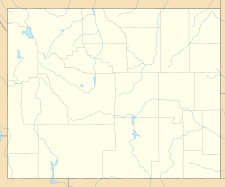Dinwoody Glacier facts for kids
Quick facts for kids Dinwoody Glacier |
|
|---|---|
| Type | Mountain glacier |
| Coordinates | 43°10′24″N 109°38′19″W / 43.17333°N 109.63861°W |
| Area | 9 km2 (2,200 acres) (in 1950) |
| Length | 3.5 km (2.2 mi) |
| Thickness | 111 m (364 ft) (1989 max) |
| Terminus | moraine/talus |
| Status | retreating |
Dinwoody Glacier is a huge ice mass located in the Shoshone National Forest in Wyoming, USA. It sits on the east side of the Continental Divide. This is like a giant ridge that separates rivers flowing to the Atlantic Ocean from those flowing to the Pacific. This glacier is one of the biggest in the American Rocky Mountains.
Discovering Dinwoody Glacier
Dinwoody Glacier is found in the Shoshone National Forest in Wyoming, USA. It's part of the Wind River Range, a tall mountain chain. The glacier is completely inside the Fitzpatrick Wilderness. This is a protected area where nature is left wild.
How Big is Dinwoody Glacier?
In 1989, Dinwoody Glacier was one of the largest glaciers in the American Rocky Mountains. It was ranked fourth in terms of its surface area. At that time, scientists measured its average thickness to be about 54 m (177 ft). The deepest part they found was an amazing 111 m (364 ft) thick! That's taller than a 30-story building.
Why is Dinwoody Glacier Shrinking?
Scientists have been studying Dinwoody Glacier for many years. A study in 1989 looked at old photos and river flow data. They found that the glacier had shrunk a lot between 1958 and 1983. Most of this shrinking was in its thickness, not just its surface area.
Over those 25 years, the glacier lost about 23.4 m (77 ft) in thickness on average. This means it became much thinner. Scientists started this study to understand how the shrinking of Dinwoody Glacier and nearby Gannett Glacier affects the water supply for streams and rivers. Glaciers act like natural water towers, storing ice and releasing water as they melt. When they shrink, it can change how much water is available.


